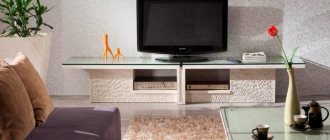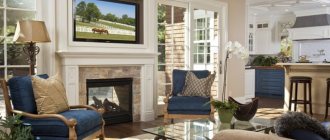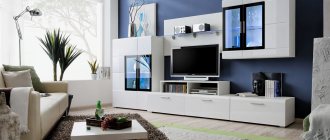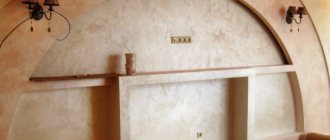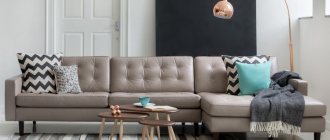Television on the wall in the interior
It is no secret that a TV in a modern home can actually be located wherever the owners wish it: in the nursery, bedroom, kitchen.
By and large, there are only two ways to place it: a bedside table (or a table as an option) and a wall.
Today's televisions are produced predominantly in flat format, and therefore their location on the wall can be considered the best placement in terms of minimizing the space taken up.
What does Xiaomi offer?
There are also interior TVs in the Xiaomi model range - in April 2020, it introduced an updated line of Mi TV TVs, which included the Mi ART model. This is actually a full-fledged competitor to Samsung The Frame, since Mi ART is also stylized as a painting and also has a remote unit, to which it is connected via a barely visible cable. Here this unit is made in the form of a soundbar, and the package also includes a subwoofer.
Xiaomi Mi Art is noticeably cheaper than Samsung The Frame
The 65-inch Mi ART uses a Samsung 4K matrix, which also displays paintings by famous artists in a special Art Mode. This Xiaomi creation costs $1040 (67.7 thousand rubles at the Central Bank exchange rate as of June 4, 2020) when ordered from China.
- The best rates for Dedicated dedicated servers on the Market.CNews IT marketplace
- Short link
bracket
The bracket is a structure to which the device is actually attached. In other words, a bracket is a mount for a TV on the wall.
- The first type of design is usually called “rigid”; it is distinguished by a clear fixation of the position of the device without changing its inclination;
- Inclined - the second type of design, allows you to tilt the device by 20° from the mounting base;
- The third, most expensive type of bracket is a tilt-and-rotate one. It features wide functionality for rotating and tilting the device in different directions.
Perhaps this concludes the question “How to mount a TV on the wall?” You can close it, now let's move on to the installation rules.
Samsung QLED TVs in Russia
The debut of Samsung TVs based on quantum dots took place in Russia in the spring of 2020. The original lineup consisted of TVs with diagonals from 49 to 88 inches, and all of them were characterized by the presence of the mentioned One Connect remote unit with connection via fiber optic cable (Picture mode and removable frames were not included, since we are not talking about The Frame line) and a universal One Remote, which allows you to control various devices connected to the TV - game consoles, Apple TV, DVD players, etc.
Samsung The Frame may also look like regular TVs with thin frames
In November 2020, Samsung began producing the world's first quantum dot TVs with 8K resolution in Russia. Their assembly started at the company’s plant in the Kaluga region, and their Russian cost at the start of production was 700 thousand rubles. for a TV with a screen diagonal of 75 inches and 1.5 million rubles. – with a diagonal of 85 inches.
Placement height
First of all, it is necessary that the TV on the wall is in the area of the viewer’s eye line or at least does not exceed 10-15% of this level.
Be sure to measure the height of the upholstered furniture in the room, then add 80 cm to the resulting value, correct for the shrinkage of the sofa and armchairs, and then install the television receiver at the required distance from the floor.
How best to place a TV in the interior
The TV in the interior is a large black rectangle and when turned off it is a kind of black hole. You may not do anything with this blackness, but it will be better and more interesting to somehow play with it and thereby neutralize it. And how you can place the TV in the interior is what I want to talk about in this article.
When choosing a TV, you should pay attention to its size: a TV that is too small will get lost in space, and one that is too large will overload it, and you won’t always be able to hang one on the wall.
Photo source: www.fangirlish.com
Decorating the wall behind the TV
The wall on which the TV is hung can be decorated with something, for example, plain wallpaper or painted, with panels or even parquet boards, lined with stone tiles, etc.
Photo source: www.behance.net
Photo source: www.shadesofblueinteriors.com
But these are simple options, but here is a more complicated option.
Photo source: www.instagram.com
Here the veneer strips are not arranged equally horizontally, but radiate out from the center, which is the TV. This arrangement does not greatly increase the budget for decoration, but adds interest and zest to the interior.
Placing the TV on/in furniture
The next option is to use various designs - niches and ledges.
Photo source: pinterest.com
You can order special furniture for video equipment.
Photo source: www.caandesign.com
Or even hide the TV from prying eyes and “take it out” only when necessary. Modern systems easily make this possible.
Photo source: www.yahoo.com
Photo source: www.contemporist.com
Photo source: www.contemporist.com
Photo source: www.contemporist.com
Photo source: www.welke.nl
TV screen as a picture
Flat TV looks like a painting. To enhance this effect, designers frame the TV with a frame - it can be a wooden frame or a frame made of polyurethane moldings, hang a picture around it and it will be an art gallery.
Photo source: pinterest.com
I especially like the example below. Since the black rectangle of the TV is surrounded on all sides by rectangles of paintings of different sizes, it does not attract much attention to itself and does not “break” the interior.
Photo source: www.homestoriesatoz.com
At what distance should the TV be placed?
The distance to the screen should be at least 3-4 screen diagonals (I wrote more about this here). Well, this is if we are talking about a plasma TV. LCD TVs can also be viewed from a distance of 2 diagonals.
And the most comfortable zone from the floor is at eye level.
Photo source: www.samsung.com
You can place the TV in almost any room of the apartment, but the main thing is where it will be convenient to watch it from all points in the room. Make sure that the sun's rays do not hit the screen, otherwise glare will ruin the entire picture. It is also not recommended to place televisions near any heating devices.
It’s also not recommended above fireplaces, but it looks so cool and adds coziness.
Photo source: www.home-dzine.co.za
Photo source: www.behance.net
Mounting a TV on the wall
Installation should be done responsibly. Not every wall can support a TV. Experts do not recommend hanging a TV weighing more than 30-35 kg on a weak plasterboard wall. Well, if you really want to, you can strengthen the TV wall by hemming it with a thick plywood sheet or building a small plasterboard ledge with a reinforced wall.
You cannot install the TV in a confined space - air must circulate freely through the ventilation holes of the TV, that is, small niches are not suitable for this. If you really want to mount a TV in a tight niche, buy special built-in LCD panels.
If you decide to hang the TV on the wall rather than on a cabinet, then use a special bracket for this. It is sold in any store along with the TV. There are different brackets: they differ in the type of TVs installed on them (plasma or LCD) and in the weight of the equipment. There are brackets with rigid fixation (fixed), brackets with the ability to adjust the tilt/rotation only vertically or only horizontally, and brackets with several possibilities for adjusting the tilt and rotation.
Photo source: id.keeprice.com
Part of the problem that arises when placing a TV in the interior is the question of where to put the wires. They can't just hang around in plain sight. As an option, you can make a cable channel in the wall if the wall is plasterboard. Two holes are made: behind the TV and below, closer to the baseboard. You can, of course, make an outlet directly behind the TV, but it is advisable to do this only if the TV is pulled out from the wall or mounted on a movable bracket.
Photo source: www.domfront.ru
You can get by with small sacrifices and not trench the wall, especially if it is concrete. Simply hide the cables and wires in a cable channel (box) on top of the wall, or make a plasterboard structure.
Photo source: pwa.olx.biz.id
Photo source: www.gria.us
These options couldn’t be simpler; any housewife can do it. The main thing is fantasy.
Photo source: www.gria.us
In general, it all depends on your preferences and budget. If the budget allows, I am for special furniture. It allows you to fit the TV into the interior most harmoniously, and, if necessary, hide it. Here's how for example.
Photo source: Turri catalog
Photo source: Vismara catalog
Which option to choose is up to you. But it’s better to use the TV somehow, don’t just leave it like that. This will add harmony to the interior and improve its Feng Shui (whatever this mysterious phrase means).
Did you like the article? — Share on social networks or leave a comment
April 21, 2017
Interior Design Examples, Interior Design Tips
Decoration and accessories, Design ideas, furniture in the interior photo, Interior design tips, Modern interior design, Modern apartment design, Feng Shui
Distance
However, the height of the TV on the wall is not the only important point during installation. The distance at which the device can be viewed for a long time without any harm to the eyes also plays a huge role.
We recommend reading:
Turquoise walls - design ideas, stylish combinations and design features (130 photos)Photo frames on the wall - placement ideas and options for decorating walls using photo frames (115 photos and videos)
Panels for wall decoration: stylish and modern wall design options. 130 photos and videos of the use of decorative panels
According to professional organizations, having a display with a fifty-inch diagonal, you need to move 3 m away from the television receiver.
In addition, there is a formula: the dimensions of the display diagonal must be multiplied by a factor of 1.56 - the resulting value will be a comfortable distance between the viewer and the TV.
If the seating area is large enough, then the device should be located exactly in the middle, since the most harmless viewing angle for the eyes during viewing does not exceed 30-35°.
Hardware Specifications
All TVs in The Frame 2020 line support Ultra HD or 4K resolution (3840x2160 pixels) and are based on QLED quantum dot technology. There are digital and analog tuners, four HDMI outputs and three USB connectors (for the 65-inch model), Ethernet, voice control (Russian language support is available) and support for the HDR10+ standard. The latter provides, among other things, automatic optimization of the contrast level and works in tandem with a light sensor, which adjusts the image brightness taking into account the level of external lighting. Additional features of the new Samsung TVs include a built-in motion sensor - if there is no one in the room, it will signal the TV to turn off to save energy.
Samsung The Frame serves for content consumption and interior decoration
The 2020 Samsung The Frame software has expanded support for Apple services and devices. The integrated iTunes Movies/TV Shows application is responsible for this, plus there is support for Apple AirPlay 2 technology.
Photo of TVs on the wall
Do you want a girl, do you want a house
The main feature of The Frame is the picture mode, which it goes into when no one is using it. In order not to waste kilowatts completely thoughtlessly, Samsung engineers placed two sensors on the front panel: one monitors the light level, the other monitors movements. The light sensor adjusts the brightness of the picture to the level of light in the room, and the motion sensor simply turns off the TV if no one moves in front of it for some time.
The TV is plump and heavy, but its backlighting is simple, edge-lit
On the one hand, this is the right approach. On the other hand, I encountered a funny bug: I tried to watch a video on YouTube at night, but the TV connected via Wi-Fi took too long to load it, leaving a spinning loading circle in the center on a dark gray background. Apparently, in the dark room the TV did not have enough light of its own, and after 15 seconds it completely turned off the screen. The fact that he was, in general, working at that moment and trying to download a video did not bother him. I had to force it to turn on again.
The TV will go out if the lights in the room are off and everyone is sleeping. But in this case, it will also turn on on its own if, for example, at six in the morning the sun starts shining through the window, so you should not refuse blackout curtains in such a situation. You can cure this behavior in a simple way - turn off the TV before going to bed by long pressing the button, without switching it to picture mode. Then The Frame will not engage in arbitrariness.
The user can only select one image for a painting: there is no slideshow mode. However, the TV allows you to assemble a collage from user photos. Three options for displaying the image are available: full screen, with a classic mat with shading, and with a “modern” mat. For small-sized images (in our case, 1200 x 630), only the option with a classic mat is available. There are several muted colors to choose from, including three shades of white and two gray options, to suit almost any image. For an already installed picture, you can select the brightness and temperature. The brightness will still change depending on the lighting, but will take the value set by the user as the reference parameter.
In Picture mode, you can adjust the warmth and brightness of the output image.
About one and a half hundred images are loaded on the TV itself, and the paid service “Art Store” offers, it seems, another 300 paintings and photographs every month for 285 rubles. Changing the image is a simple process, controlled both from the TV itself and from a smartphone.
In general, sitting with a picture TV in the same room is pleasant. The soft, slightly dimmed light of the screen gives a feeling of strange calm, which, however, disappears after the realization that this hefty photo frame actually does nothing and eats up kilowatts. Dynamic brightness adjustment works smoothly, but even with it, The Frame consumed an additional 60 kWh in two weeks of infrequent use. Art is still not free, even in museums, and even less so at home. I see the development of this functionality in the schedule, which allows the user to set operating hours for the painting mode. Still, the TV does not have enough intelligence to make adequate decisions.
TV in a baguette frame: how to bring this idea to life
If you have come to the conclusion that you simply need a frame for your TV, we will help you realize such an idea. First of all, in the Run Art workshop they will offer you many models of baguette so that you can decide how you want to design your equipment. It should be noted that all our frames for TVs are of the highest quality and impeccable reliability, as well as a very attractive appearance. After you decide on the shade, width and material of the frame, we will begin the design work, which we will complete as quickly as possible and with very high quality. You can be sure that the frame for your TV will be reliable and will give your equipment the most stylish look. We carry out such registration very quickly, without making clients wait long. Please note that our prices for such services are highly affordable and attractive, so all aesthetes will be able to decorate a TV in a baguette frame by contacting Run Art.

